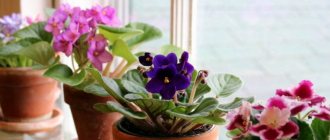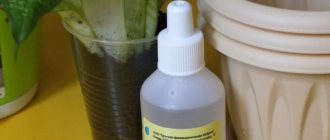Every first Ukrainian apartment or house has indoor plants. With rare exceptions. First of all, it's beautiful. And secondly, by the way, too. The beauty and visual appeal of indoor flowers is the main advantage of flora living in pots. But this is only at first glance. In fact, there is a more important plus: the ability of indoor plants to absorb negative energy and produce oxygen. We are sure that you have repeatedly heard that indoor plants purify the air in the room in which they grow. Today we want to talk about those domesticated representatives of the flora that produce oxygen not only in daylight, but also at night.
The list that you will find below will be useful to you if you want to organize your home or office space in a special way, filling it with plants that will actively work to purify the air. We are sure that you are familiar with most of the participants on this list. This means we don’t have to prove to you that these indoor green beauties are not only useful, but also incredibly beautiful.
Aloe vera
It would be strange if we named some other plant first, and not aloe vera. When our parents were young, aloe was in every home. Many people did not know then that this flower reproduces oxygen within 24 hours. However, they knew that aloe juice has a lot of useful properties, including valuable antiseptic properties. It was then and now used and continues to be used to treat many diseases. It is a good natural “medicine” for your home medicine cabinet and a popular ingredient in natural cosmetics and modern pharmaceuticals.
Among all the participants on our list, it is aloe vera that produces the greatest amount of oxygen at night. At the same time, the indoor flower is completely unpretentious. It does not require close attention from the grower and will not be offended even if you forget to water it several times in a row.
To get the maximum effect from growing aloe vera at home, experts recommend planting one plant in each room of your apartment or house.
Welcome to the bedchamber
For a room where a person spends his time mainly in the dark, plants that produce the most oxygen at night rather than absorb it when a person sleeps are more suitable. After all, if there is a lack of a vital element, headaches and constant fatigue will occur. So what kind of indoor plants will give their owners oxygen and healthy sleep at night? We offer the TOP of the most generous and affordable types.
Sansevieria
Sansevieria can be considered the leader in the ranking of plants that produce oxygen. For its long, hard and sharp-tipped leaves, it was popularly called “mother-in-law’s tongue” or “pike tail”. In addition, this representative of succulents is capable of releasing large amounts of oxygen day and night. So, it also absorbs harmful volatile compounds that are released by furniture and other household items. We can say that there is no better inhabitant for a bedroom. It is enough to place one flower for each person spending the night in the room.
According to NASA, Sansevieria is one of the ten best “green filters” for air.
Aloe
Another representative of the genus of succulents, with a long history, used by many as an effective folk medicine. We are, of course, talking about aloe. The juice of this plant is used in the treatment of many diseases. In addition, by placing the plant in the bedroom, you can enrich the air with oxygen at night and clear formaldehyde from the air around the clock. Moreover, aloe is unpretentious in care, which attracts the attention of novice gardeners.
Kalanchoe
A representative of succulents and a good “specialist” in oxygen synthesis at night is Kalanchoe. It calms, helps get rid of negative mood and depression and also does not require much attention, just more sunlight.
Orchid
Refined orchids delight their owners with beautiful flowers and decorate the house. But few people know that they also purify the air in a closed space from such a harmful substance as xylene, which is released from many types of paints. And the main advantage can be considered the ability to produce large amounts of oxygen at night, and this with minimal expenditure of attention and effort in care.
But florists do not recommend decorating the bedroom with this flower, since the orchid is an energy vampire and is most active at night.
Spathiphyllum
Spathiphyllum, also known as “women’s happiness,” is a real home worker. It is ideal for any room during the heating season, because it is able to humidify the air, as well as remove benzene and produce oxygen when a person sleeps. Moreover, the rich green leaves and unusual flowers will decorate the interior of any bedroom.
Chamomile
Beautiful bright “daisies” of indoor gerbera will give any room a spring atmosphere and a great mood. But in return, this sophisticated plant will require a little special treatment, attention and care. Fortunately, all the efforts made will not be in vain, and the gerbera will fully thank its owners with clean air at night and pleasing flowers in the morning.
Geranium
Indeed, geranium can be called a unique indoor plant. More than one generation of our ancestors treated it with reverence, choosing the best place in the hut and talking to the plant every day. In addition to “producing” oxygen at night, geranium saturates the air with ozone and cleanses it of microbes.
A distinctive feature of this plant is that it is a strong energy donor. Moreover, the miracle flower has a beneficial effect on hormone levels in women, calms the nervous system, normalizes blood pressure, strengthens the immune system and saves from insomnia. One could say that geranium should grow in every home, in every room, if not for one “but” - allergy sufferers and asthmatics need to be careful with it, because the essential oils released can harm such people.
Chlorophytum
Many housewives grow inconspicuous, at first glance, chlorophytum at home, not suspecting that this is a real “factory” for cleaning the room. 4 plants per day can remove up to 90% of formaldehyde over an area of 10 sq.m. around you. And, of course, chlorophytum adds oxygen and humidifies the air at night.
Laurel, lavender and rosemary
Laurel, lavender and rosemary may not be champions in oxygen production, but their calming and relaxing properties have a beneficial effect on human sleep. By placing a flowerpot with one of them in the bedroom, you can get rid of migraines, bring blood pressure back to normal, improve and purify the air in the room, relieve nervous tension and significantly improve sleep.
Laurel
Lavender
Rosemary
The plants presented above are rather exceptions to the rule. This choice for a bedchamber is due to the ability of a number of plants to produce oxygen and absorb carbon dioxide in the dark.
It’s also not worth it to oversaturate the bedroom with such nocturnal “hard workers” - there should be moderation in everything.
Sansevieria
This indoor plant has many popular names. Sansevieria, which has a long leaf, is called “mother-in-law’s tongue” - because it is long. And knocked down compact bushes of sansevieria, which have short leaves, are often called “snake skin”. Apparently, for the variegated color, which the leaves are guaranteed to include different shades of green.
Today, pots of Sansevieria can often be found in the interior of catering establishments. If you don’t believe that this plant will decorate your home space, stop by your favorite restaurant and see for yourself. Just like aloe, Sansevieria is completely unpretentious. All it needs is watering. Water the soil as it dries out. Sansevieria does not need any other manipulations. She, of course, will be grateful to you for both spraying and feeding. But if you don’t waste time on this, the plant will understand your decision and will still produce oxygen 24 hours a day.
Spathiphyllum
This plant does not have a single stem, oval or lanceolate leaves grow directly from the ground in bushes, the flowers are very beautiful and delicately fragrant.
Spathiphyllum removes harmful chemicals from the air, such as those emitted by furniture and household appliances.
Spathiphyllum loves regular watering and spraying and does not tolerate drafts.
Suitable for almost any interior, both home and office. It is better to place the plant in a bright place, but not in very strong lighting - a bathroom with a window, a bedroom, a nursery.
Azadirachta indica
This plant also has a shorter name - neem. People call this indoor flower a plant of purity. Firstly, due to the volume of oxygen produced. And secondly, thanks to the ability to purify not only the air, but also the atmosphere in the house. It is believed that neem actively processes negative energy and produces positive energy instead. And those who believe in such properties of indoor plants are sure that this is precisely the main and most valuable quality of Indian azadirachta.
An important advantage of azadirachta is that it acts on the air as a natural pesticide. This means that you don’t have to use “Raptor” in an apartment where there is a pot with this plant: midges, flies and mosquitoes will avoid it. That is, the plant will, in fact, create an invisible barrier between you and annoying insects.
In order for it to feel comfortable in your home and for it to efficiently perform all its stated functions, it is necessary to provide it with suitable soil and an abundance of sunlight.
How many plants do you need?
A standard office ventilation system allows you to completely change the air in the room once an hour; to ensure the same effect, you need to place a thousand plants in a small office (3 by 3 meters)! And even if you ignore the fact that they will take up too much space, other difficulties will appear - for example, dust will accumulate on the leaves and on the floor between the pots, and the humidity in the room will become higher.
A growing number of experts say that plants can certainly remove some pollutants from the air—but only partially and, crucially, in the laboratory. The authors of a recent publication in the Journal of Exposure Science & Environmental Epidemiology examined twelve studies of nearly two hundred plants and came to the conclusion that plants do not purify the air in the home. As one of the authors told National Geographic, “We're not saying the experimental data is wrong; we only emphasize that they are experimental.”
Fine basil
Tulsi or fine-flowered basil not only sounds perfect in salads, soups and other dishes, but it also smells great. That is, flower growers will appreciate this beauty not only as an aromatic seasoning, but also as an air freshener in the house. Doctors say that the aroma of basil has a positive effect on the human nervous system: it calms, relieves stress, normalizes sleep, and even helps fight such severe and protracted painful conditions as depression.
It is best to place the tulsi pot in the room in which you relax. That is, in the living room or bedroom. If there are small children in the house, then fine basil can be planted on the windowsill in the nursery. They say that the plant has a beneficial effect on a baby's sleep and calms the baby during the period when he is attacked by colic or teething.
Orchid
At home we most often keep phalaenopsis - orchids, which are popularly nicknamed “butterflies”. It turns out that they are not only very tenacious and can go without watering for a long time, but they are also very useful, as they are able to produce oxygen 24 hours a day - without breaks, weekends and holidays. It is believed that phalaenopsis produces the greatest amount of oxygen in the dark. From this point of view, you need to find a place for a pot (or pots - if there is more than one phalaenopsis) where you sleep.
There is a myth that orchids are extremely whimsical plants. In reality, everything is exactly the opposite. Phalaenopsis does not require any attention from the grower at all - not at all. All it needs is at least more or less regular watering, as well as an abundance of sunlight.
What then are the benefits of indoor plants?
Indoor flowers lift your spirits and calm you down; caring for them can be a meditative experience, and in order to simply water them, you need to at least take a break from gadgets or screens, get up and move a little. If you grow edible herbs or fruits, then your kitchen is partly working on the zero kilometer principle - so the environment suffers a little less. Houseplants are known to reduce psychological and physiological stress and help people feel happier. And even though they don’t purify the air or add oxygen, they look great on Instagram and allow you to change the appearance of a room without much expense.
Orange gerbera
Gerbera, which decorates the house both at the time of flowering and at the moment of rest, is also a multifunctional indoor plant. It is logical that if it is present on this list, then its capabilities are not limited only to the round-the-clock production of oxygen (although, you see, this is already more than enough). It is believed that the phytoncides that orange gerberas release into the air protect people from cancer. In addition, gerbera is able to absorb benzene, which is released by other objects and phenomena. And only a few among indoor flowers are capable of this.
Carbon dioxide , which a person exhales in the process of life, is absorbed by the orange gerbera. Instead, the flower produces pure oxygen. The presence of a plant in the house has a beneficial effect on the state of the nervous system of all household members. Many noted that with the appearance of gerberas in the house they became calmer, stopped getting nervous over trifles, began to fall asleep better and sleep more soundly.
Anthurium
One of the most popular and not very capricious indoor plants.
The main advantage of the plant is its bright “flowers” - from deep red to snow-white, there are also purple, burgundy, and green.
Anthurium absorbs many toxins. And even capable of reducing electromagnetic radiation.
Anthurium loves high humidity and a lot of light, but it should be protected from drafts and direct sunlight.
It is better to place it in the kitchen and office.
Ficus benjamina
Several decades ago, ficus benjamina was an extremely unwelcome guest in the house. And there was no question of putting him in an apartment. And all because several “yellow” newspapers in the 90s dispelled the myth that, supposedly, the souls of the dead live in the leaves of this plant, and therefore, growing it in the house is strictly prohibited. It’s so good that you and I have learned to distinguish truth from fiction and, despite the total Soviet past, have learned to think logically. Now such beauties as Ficus Benjamin live in our apartments - they delight us with their presence and work for our benefit.
The fact that ficus is a powerful source of oxygen, we believe, is already clear. But you may not have heard that its leaves are actively used to treat diabetes. In addition, ficus benjamina leaf extract is an integral ingredient in anti-constipation medications. And you say, souls of the dead! What kind of souls are there if he heals the living?
Decembrist
The official name of this plant is Rozhdestvennik cactus. And the plant was popularly called the Decembrist because it blooms in December, on the eve of the New Year. And this is especially nice, because in winter there is so little color around. Decembrist, like several plants on the list before it, produces maximum oxygen at night, that is, when the grower and household members are resting. Therefore, the best place for it would be a window sill in the bedroom or in the nursery, where representatives of the younger generation sleep.
Dracaena marginata (Dracaena marginata)
This tree resembles a palm tree, although it is not one. Dracaena can grow up to 3 meters, but it always looks elegant and interesting. Dracaena fringe is superior to all other types of dracaena in its ability to purify the air.
It is capable of absorbing up to 70% of hazardous impurities, including ammonia, as well as any substances emitted by paints, varnishes, glues, building materials, and decorative coatings. Shows disinfectant and phytoncidal activity.
The plant prefers places that do not receive direct sunlight and a temperature of at least 15 degrees.
It is necessary to maintain stable soil moisture, without dampness or dryness, apply fertilizer every 2 weeks and spray periodically.
Rooms suitable for this plant: bedroom, living room, dressing room.
Kalanchoe
First of all, Kalanchoe is a very beautiful plant. Any interior in which this blooming beauty appears is instantly transformed. It is noteworthy that Kalanchoe flowers can be matched to the interior, creating a kind of harmony. The varietal varieties of this representative of the flora are limitless, so you can choose a soft yellow, snow-white, hot pink, lilac, or purple flower for your home. But besides this, Kalanchoe is also a very useful plant. It produces oxygen both day and night - and at an equally intense pace. But in order for the flower to feel comfortable, it needs to be allocated a sunny location and watered regularly, avoiding overflow and drought in the pot.
Representatives of the palm family
All palm trees and palms that humans have managed to domesticate actively process carbon dioxide, and instead supply oxygen into the indoor atmosphere. This is why palm trees are so often found in clinics, offices, government agencies and other facilities that are visited by hundreds, and maybe even thousands of people every day.
Interestingly, palm trees do more than just produce oxygen. They release beneficial microelements into the air. They also moisturize it no worse than a household appliance. Members of the palm family do not need sunlight to grow. They feel great in shaded spaces.
Dieffenbachia
Plants that purify the air would be appropriate in the apartment space. Dieffenbachia not only absorbs carbon dioxide and releases oxygen, but also has an amazing ability, inherent in nature, to destroy staphylococci. The plant has a unique ability to capture and destroy toxic substances. Floor and wall paints release toluene and xylene, which are absorbed by the purifying plant. This plant also purifies the air from formaldehyde. It is not capricious. It is enough to water it once a week, and it will adapt to the lighting.











